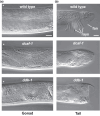The Caenorhabditis elegans cullin-RING ubiquitin ligase CRL4DCAF-1 is required for proper germline nucleolus morphology and male development
- PMID: 37433110
- PMCID: PMC10686702
- DOI: 10.1093/genetics/iyad126
The Caenorhabditis elegans cullin-RING ubiquitin ligase CRL4DCAF-1 is required for proper germline nucleolus morphology and male development
Abstract
Cullin-RING ubiquitin ligases (CRLs) are the largest class of ubiquitin ligases with diverse functions encompassing hundreds of cellular processes. Inactivation of core components of the CRL4 ubiquitin ligase produces a germ cell defect in Caenorhabditis elegans that is marked by abnormal globular morphology of the nucleolus and fewer germ cells. We identified DDB1 Cullin4 associated factor (DCAF)-1 as the CRL4 substrate receptor that ensures proper germ cell nucleolus morphology. We demonstrate that the dcaf-1 gene is the ncl-2 (abnormal nucleoli) gene, whose molecular identity was not previously known. We also observed that CRL4DCAF-1 is required for male tail development. Additionally, the inactivation of CRL4DCAF-1 results in a male-specific lethality in which a percentage of male progeny arrest as embryos or larvae. Analysis of the germ cell nucleolus defect using transmission electron microscopy revealed that dcaf-1 mutant germ cells possess significantly fewer ribosomes, suggesting a defect in ribosome biogenesis. We discovered that inactivation of the sperm-fate specification gene fog-1 (feminization of the germ line-1) or its protein-interacting partner, fog-3, rescues the dcaf-1 nucleolus morphology defect. Epitope-tagged versions of both FOG-1 and FOG-3 proteins are aberrantly present in adult dcaf-1(RNAi) animals, suggesting that DCAF-1 negatively regulates FOG-1 and FOG-3 expression. Murine CRL4DCAF-1 targets the degradation of the ribosome assembly factor periodic trptophan protein 1 (PWP1). We observed that the inactivation of Caenorhabditis elegansDCAF-1 increases the nucleolar levels of PWP1 in the germ line, intestine, and hypodermis. Reducing the level of PWP-1 rescues the dcaf-1 mutant defects of fewer germ cell numbers and abnormal nucleolus morphology, suggesting that the increase in PWP-1 levels contributes to the dcaf-1 germline defect. Our results suggest that CRL4DCAF-1 has an evolutionarily ancient role in regulating ribosome biogenesis including a conserved target in PWP1.
Keywords: DCAF1; germ cell; male lethality; male tail; nucleolus; ribosome biogenesis.
© The Author(s) 2023. Published by Oxford University Press on behalf of The Genetics Society of America. All rights reserved. For permissions, please e-mail: journals.permissions@oup.com.
Conflict of interest statement
Conflicts of interest: The author(s) declare no conflict of interest.
Figures






Similar articles
-
C. elegans nucleostemin is required for larval growth and germline stem cell division.PLoS Genet. 2008 Aug 22;4(8):e1000181. doi: 10.1371/journal.pgen.1000181. PLoS Genet. 2008. PMID: 18725931 Free PMC article.
-
CRL4DCAF1/VprBP E3 ubiquitin ligase controls ribosome biogenesis, cell proliferation, and development.Sci Adv. 2020 Dec 18;6(51):eabd6078. doi: 10.1126/sciadv.abd6078. Print 2020 Dec. Sci Adv. 2020. PMID: 33355139 Free PMC article.
-
Arabidopsis DDB1-CUL4 ASSOCIATED FACTOR1 forms a nuclear E3 ubiquitin ligase with DDB1 and CUL4 that is involved in multiple plant developmental processes.Plant Cell. 2008 Jun;20(6):1437-55. doi: 10.1105/tpc.108.058891. Epub 2008 Jun 13. Plant Cell. 2008. PMID: 18552200 Free PMC article.
-
Cullin 4-DCAF Proteins in Tumorigenesis.Adv Exp Med Biol. 2020;1217:241-259. doi: 10.1007/978-981-15-1025-0_15. Adv Exp Med Biol. 2020. PMID: 31898232 Review.
-
Sex determination in the Caenorhabditis elegans germ line.Curr Top Dev Biol. 2008;83:41-64. doi: 10.1016/S0070-2153(08)00402-X. Curr Top Dev Biol. 2008. PMID: 19118663 Review.
References
Publication types
MeSH terms
Substances
Grants and funding
LinkOut - more resources
Full Text Sources
Research Materials
Miscellaneous

